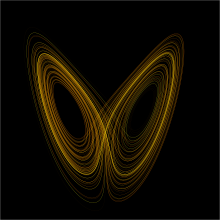
Back نظام تحريكي Arabic Sistema dinámicu AST Динамична система Bulgarian Sistema dinàmic Catalan Dynamický systém Czech Dynamisk system Danish Dynamisches System German Δυναμικό σύστημα Greek Sistema dinámico Spanish Dünaamiline süsteem Estonian
This article includes a list of general references, but it lacks sufficient corresponding inline citations. (February 2022) |

In mathematics, a dynamical system is a system in which a function describes the time dependence of a point in an ambient space, such as in a parametric curve. Examples include the mathematical models that describe the swinging of a clock pendulum, the flow of water in a pipe, the random motion of particles in the air, and the number of fish each springtime in a lake. The most general definition unifies several concepts in mathematics such as ordinary differential equations and ergodic theory by allowing different choices of the space and how time is measured.[citation needed] Time can be measured by integers, by real or complex numbers or can be a more general algebraic object, losing the memory of its physical origin, and the space may be a manifold or simply a set, without the need of a smooth space-time structure defined on it.
At any given time, a dynamical system has a state representing a point in an appropriate state space. This state is often given by a tuple of real numbers or by a vector in a geometrical manifold. The evolution rule of the dynamical system is a function that describes what future states follow from the current state. Often the function is deterministic, that is, for a given time interval only one future state follows from the current state.[1][2] However, some systems are stochastic, in that random events also affect the evolution of the state variables.
In physics, a dynamical system is described as a "particle or ensemble of particles whose state varies over time and thus obeys differential equations involving time derivatives".[3] In order to make a prediction about the system's future behavior, an analytical solution of such equations or their integration over time through computer simulation is realized.
The study of dynamical systems is the focus of dynamical systems theory, which has applications to a wide variety of fields such as mathematics, physics,[4][5] biology,[6] chemistry, engineering,[7] economics,[8] history, and medicine. Dynamical systems are a fundamental part of chaos theory, logistic map dynamics, bifurcation theory, the self-assembly and self-organization processes, and the edge of chaos concept.
- ^ Strogatz, S. H. (2001). Nonlinear Dynamics and Chaos: with Applications to Physics, Biology and Chemistry. Perseus.
- ^ Katok, A.; Hasselblatt, B. (1995). Introduction to the Modern Theory of Dynamical Systems. Cambridge: Cambridge University Press. ISBN 978-0-521-34187-5.
- ^ "Nature". Springer Nature. Retrieved 17 February 2017.
- ^ Melby, P.; et al. (2005). "Dynamics of Self-Adjusting Systems With Noise". Chaos: An Interdisciplinary Journal of Nonlinear Science. 15 (3): 033902. Bibcode:2005Chaos..15c3902M. doi:10.1063/1.1953147. PMID 16252993.
- ^ Gintautas, V.; et al. (2008). "Resonant forcing of select degrees of freedom of multidimensional chaotic map dynamics". J. Stat. Phys. 130 (3): 617. arXiv:0705.0311. Bibcode:2008JSP...130..617G. doi:10.1007/s10955-007-9444-4. S2CID 8677631.
- ^ Jackson, T.; Radunskaya, A. (2015). Applications of Dynamical Systems in Biology and Medicine. Springer.
- ^ Kreyszig, Erwin (2011). Advanced Engineering Mathematics. Hoboken: Wiley. ISBN 978-0-470-64613-7.
- ^ Gandolfo, Giancarlo (2009) [1971]. Economic Dynamics: Methods and Models (Fourth ed.). Berlin: Springer. ISBN 978-3-642-13503-3.